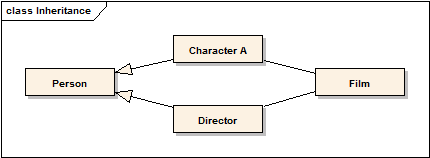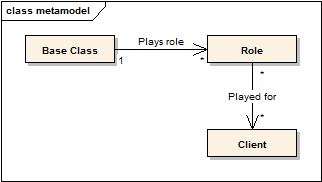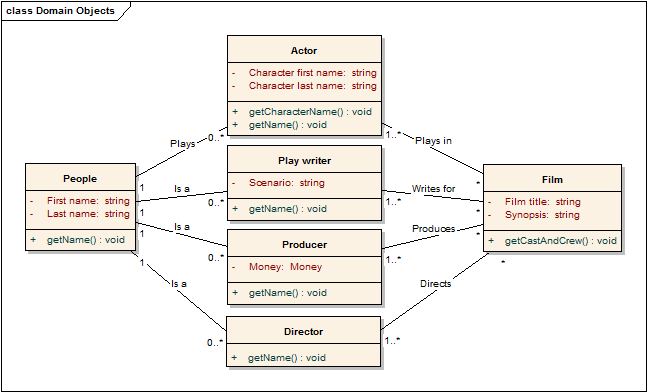
Role Class Model
Encyclopedia
In computer science, the role class model is a role analysis pattern
described (but not invented ) by Francis G. Mossé in his article on Modelling Roles. The role class pattern provides the ability for a class to play multiple roles and to embed the role characteristic in a dedicated class.
In our society, as we built it, roles are everywhere. Anyone trying to work in a team to create something has a role. In cinematography
, many different persons take part in the creation of a film: the film director
, the producer
, actors, play writer(s), etc.
Even our State organisations are based on various roles. In a Republic
, you have a President
, Ministers, Deputies, etc.
Dealing with these situations is one of the problems encountered most during object-oriented analysis. Francis G. Mossé has identified 5 role analysis patterns that can be used to solve most role related problems: Role Inheritance, Association Roles, Role Classes, Generalised Role Classes and Association Class Roles. They all have various degrees of constraints, flexibility or power, which together offer a complete solution to most role-related problems.
This article describes the topic Role Classes.
Many persons work on a film, each of them with a different role. At the difference of other concepts, a person is not restricted to one role. One could be both the director
and a character
in a film. Modelling roles for such a concept would require that a class could play more than a single role.
A solution using inheritance
to conceptualise a role - cf. the Inheritance Role Model - is not possible, as this would allow a person to play only a single role. As one can see in Figure 1 below, the inheritance role model says that a character, who is a person, is playing in a film. But there is no way to say that the person playing the character is also the director. Because, the inheritance makes a character a person in general, not a particular person.

The expectation is to have a model where a class could be seen as more than one concept or role, and where attributes specific to one of those concepts can be specified.
 This meta model - in Figure 2 - shows the role class like an element linking the Client and the BaseClass. For the Client interacting with the Role is like interacting with the Base Class itself, but from the perspective it is expecting. The advantage having the role as a class is that attributes can be bound to it.
This meta model - in Figure 2 - shows the role class like an element linking the Client and the BaseClass. For the Client interacting with the Role is like interacting with the Base Class itself, but from the perspective it is expecting. The advantage having the role as a class is that attributes can be bound to it.
 A simple application of the role class model in a real example is in the 7th art (see Figure 3), the cinematography. This art involves a creation (the Film) and people to create it. Each person has a different role in the film, they could be actors and play characters, they could be director or scenarist, etc. A person is not limited to one role in a film, they can be both actors and directors and even more. For example, the film Scoop (2006)
A simple application of the role class model in a real example is in the 7th art (see Figure 3), the cinematography. This art involves a creation (the Film) and people to create it. Each person has a different role in the film, they could be actors and play characters, they could be director or scenarist, etc. A person is not limited to one role in a film, they can be both actors and directors and even more. For example, the film Scoop (2006)
has been directed by Woody Allen
, he is also the scenarist and he plays the role of Sid Waterman.
 In Figure 4, one can see in more detail the role that each person can play in a film. From the film, it is possible to ask the list of crews and cast that help elaborated it. Each person has one or more roles (e.g. actor, director, producer, cameraman, etc.) in the film and can participate in more than one film. A person could even be an actor in a film and a producer in another. One advantage of using a role class in the case of the actor role is that the character qualities can be stored within the role. This is true for the actor role, this is also true for other roles, however maybe not all.
In Figure 4, one can see in more detail the role that each person can play in a film. From the film, it is possible to ask the list of crews and cast that help elaborated it. Each person has one or more roles (e.g. actor, director, producer, cameraman, etc.) in the film and can participate in more than one film. A person could even be an actor in a film and a producer in another. One advantage of using a role class in the case of the actor role is that the character qualities can be stored within the role. This is true for the actor role, this is also true for other roles, however maybe not all.
Only a few of the possible role have been modelled in Figure 4. One remark easily visible is that not all the role needs attributes and using the role class model for all of them is unnecessary (like for the Director role). In addition, there is a lot of redundancy between each role class. Redundancy in computer science
means more work in maintenance, which is not wished.
. The analysis pattern “Role Class Model” offers a possibility to employ a model with linking between a base class and the client. In addition inheritance is not a part of the solution because of the flexibility of zero or multiple roles (role-specific attributes and operations).
Strength implies also its counter part's weakness. The problem of the role class model is the redundancy, for example the method getName is visible in all of the role classes described in Figure 4. If this is considered inconvenient, the role class generalisation model as defined in Modelling Roles is a possible way to go.
Software analysis pattern
Software analysis patterns or analysis patterns in software engineering are conceptual models, which capture an abstraction of a situation that can often be encountered in modelling...
described (but not invented ) by Francis G. Mossé in his article on Modelling Roles. The role class pattern provides the ability for a class to play multiple roles and to embed the role characteristic in a dedicated class.
In our society, as we built it, roles are everywhere. Anyone trying to work in a team to create something has a role. In cinematography
Cinematography
Cinematography is the making of lighting and camera choices when recording photographic images for cinema. It is closely related to the art of still photography...
, many different persons take part in the creation of a film: the film director
Film director
A film director is a person who directs the actors and film crew in filmmaking. They control a film's artistic and dramatic nathan roach, while guiding the technical crew and actors.-Responsibilities:...
, the producer
Film producer
A film producer oversees and delivers a film project to all relevant parties while preserving the integrity, voice and vision of the film. They will also often take on some financial risk by using their own money, especially during the pre-production period, before a film is fully financed.The...
, actors, play writer(s), etc.
Even our State organisations are based on various roles. In a Republic
Republic
A republic is a form of government in which the people, or some significant portion of them, have supreme control over the government and where offices of state are elected or chosen by elected people. In modern times, a common simplified definition of a republic is a government where the head of...
, you have a President
President
A president is a leader of an organization, company, trade union, university, or country.Etymologically, a president is one who presides, who sits in leadership...
, Ministers, Deputies, etc.
Dealing with these situations is one of the problems encountered most during object-oriented analysis. Francis G. Mossé has identified 5 role analysis patterns that can be used to solve most role related problems: Role Inheritance, Association Roles, Role Classes, Generalised Role Classes and Association Class Roles. They all have various degrees of constraints, flexibility or power, which together offer a complete solution to most role-related problems.
This article describes the topic Role Classes.
Intent
A model that allows a class to play one or more role at the same time. A role - as defined by Francis Mossé in Modelling Roles - is a concept of a purpose that a class could have in a certain context.Context
The following example is given:Many persons work on a film, each of them with a different role. At the difference of other concepts, a person is not restricted to one role. One could be both the director
Film director
A film director is a person who directs the actors and film crew in filmmaking. They control a film's artistic and dramatic nathan roach, while guiding the technical crew and actors.-Responsibilities:...
and a character
Fictional character
A character is the representation of a person in a narrative work of art . Derived from the ancient Greek word kharaktêr , the earliest use in English, in this sense, dates from the Restoration, although it became widely used after its appearance in Tom Jones in 1749. From this, the sense of...
in a film. Modelling roles for such a concept would require that a class could play more than a single role.
A solution using inheritance
Inheritance
Inheritance is the practice of passing on property, titles, debts, rights and obligations upon the death of an individual. It has long played an important role in human societies...
to conceptualise a role - cf. the Inheritance Role Model - is not possible, as this would allow a person to play only a single role. As one can see in Figure 1 below, the inheritance role model says that a character, who is a person, is playing in a film. But there is no way to say that the person playing the character is also the director. Because, the inheritance makes a character a person in general, not a particular person.

Problem
As explained in Context, using inheritance to play more than one role cannot be considered, because a class could not play two roles at the same time in such a context (cf. the Inheritance Role Model).The expectation is to have a model where a class could be seen as more than one concept or role, and where attributes specific to one of those concepts can be specified.
Solution
A solution to the previous problem could be to use the Association Role Model, which could create an association between a person and a film. However, specific information on each role could not be stored in such a case. The role class model provides the flexibility of the association with role-specific attributes and even class operations, if needed.
Cinema

Scoop (2006 film)
Scoop is a 2006 American-British romantic comedy/murder mystery written and directed by Woody Allen and starring Hugh Jackman, Scarlett Johansson, Ian McShane, and Allen himself...
has been directed by Woody Allen
Woody Allen
Woody Allen is an American screenwriter, director, actor, comedian, jazz musician, author, and playwright. Allen's films draw heavily on literature, sexuality, philosophy, psychology, Jewish identity, and the history of cinema...
, he is also the scenarist and he plays the role of Sid Waterman.

Only a few of the possible role have been modelled in Figure 4. One remark easily visible is that not all the role needs attributes and using the role class model for all of them is unnecessary (like for the Director role). In addition, there is a lot of redundancy between each role class. Redundancy in computer science
Computer science
Computer science or computing science is the study of the theoretical foundations of information and computation and of practical techniques for their implementation and application in computer systems...
means more work in maintenance, which is not wished.
Strengths and weaknesses
The employment of this model depends on the business processBusiness process
A business process or business method is a collection of related, structured activities or tasks that produce a specific service or product for a particular customer or customers...
. The analysis pattern “Role Class Model” offers a possibility to employ a model with linking between a base class and the client. In addition inheritance is not a part of the solution because of the flexibility of zero or multiple roles (role-specific attributes and operations).
Strength implies also its counter part's weakness. The problem of the role class model is the redundancy, for example the method getName is visible in all of the role classes described in Figure 4. If this is considered inconvenient, the role class generalisation model as defined in Modelling Roles is a possible way to go.
See also
Francis G. Mossé has described other solutions to the role problem.- Role Inheritance
- Association Roles
- Generalised Role Classes
- Association Class Roles
- Association Class Roles with role type, which is a refinement of the previous.
Further reading
An introduction to object-oriented analysis with conceptual modelsRelated links
- Actor-Role Pattern, A JPA Implementation http://www.ibstaff.net/fmartinez/?p=16

